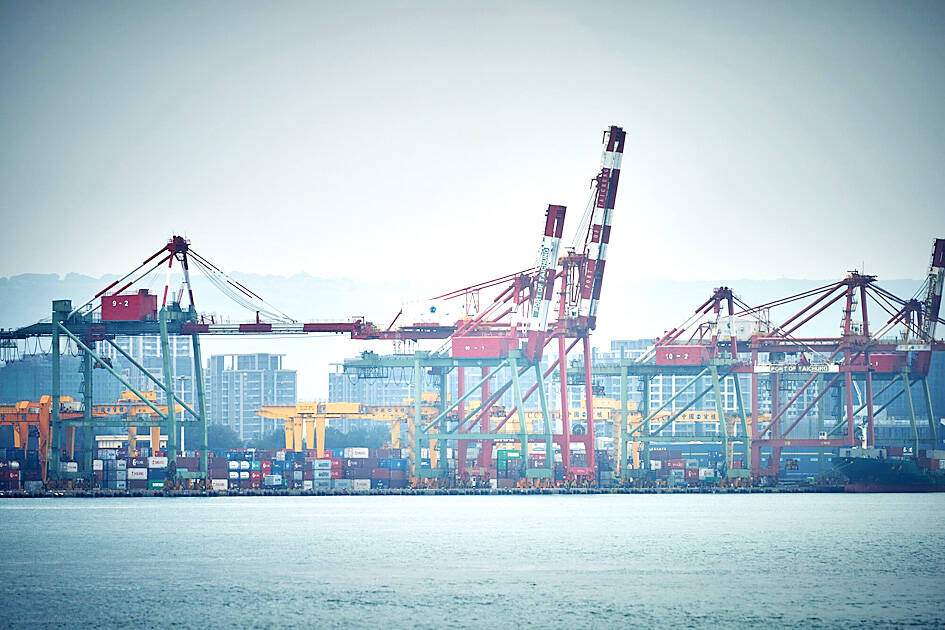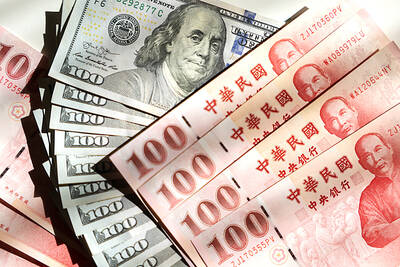Taiwan’s GDP is forecast to grow 4.36 percent year-on-year this year, as the economy is expected to benefit from rising exports and stable private investment, led by semiconductor companies and firms linked to the artificial intelligence (AI) boom, Yuanta Securities Investment Consulting Co (元大投顧) said on Friday.
The forecast represents a 0.67 percentage point increase from its previous estimate of 3.69 percent in March, Yuanta said in a report.
Major research institutes since April have raised their predictions for Taiwan’s economic growth this year, with the estimated growth ranging from 3 percent to 3.94 percent — higher than the average of 3.14 percent over the past 10 years.

Photo: Bloomberg
The Directorate-General of Budget, Accounting and Statistics (DGBAS) late last month also lifted its GDP growth forecast for this year from 3.43 percent to 3.94 percent, exceeding the annual growth target of 3.5 percent set by the National Development Council.
Yuanta’s upward revision came after GDP in the first quarter of the year increased by 6.56 percent from a year earlier — an 11-quarter high — beating its March prediction by 0.6 percentage points, the report said.
It also came as the world’s economy is projected to grow steadily this year, with global trade in goods expected to expand by 2.3 to 3.2 percent year-on-year this year, compared with an increase of 0.1 to 1 percent last year — which would help boost Taiwan’s exports, it said.
Taiwan’s exports expanded 9.1 percent year-on-year during the first five months of this year, higher than the average growth of 3.9 percent for the same period over the past 10 years and indicating strong momentum in external demand, the report said.
Local manufacturers are also to complete their inventory adjustments in the next few months, which would boost firms’ capacity utilization and contribute to shipment growth, it said.
Moreover, Taiwan’s export structure is also improving, as outbound shipments of electronic products increased nearly 20 percent in the first five months, becoming a major pillar of the economy, and the decline in non-electronic exports shrank significantly, reducing its drag on overall exports, the report said.
As a result, Yuanta upgraded its Taiwan export growth forecast by 2.33 percentage points to 8.51 percent this year, compared with the DGBAS’ 10.06 percent growth forecast.
Yuanta also raised its growth estimates for private consumption and private investment by 0.2 percentage points and 1.32 percentage points to 3.22 percent and 3.31 percent respectively. In comparison, the DGBAS last month upgraded its growth estimates to 2.77 percent for private consumption and 1.52 percent for private investment this year.
The consumer price index is projected to rise by 2.22 percent this year, 0.04 percentage points faster than the March forecast, after taking into account recent electricity rate hikes and the stickiness of inflation in the services industry, Yuanta said.
Yuanta’s inflation projection is above the central bank’s 2 percent target for the third consecutive year, warranting further interest rate hikes by the monetary authority in the future, it said.
The central bank early this month kept its policy rates unchanged, but further adjusted the selective credit control measures and raised the reserve requirement ratio by 0.25 percentage points to cool the property market and tighten liquidity.

MARKET LEADERSHIP: Investors are flocking to Nvidia, drawn by the company’s long-term fundamntals, dominant position in the AI sector, and pricing and margin power Two years after Nvidia Corp made history by becoming the first chipmaker to achieve a US$1 trillion market capitalization, an even more remarkable milestone is within its grasp: becoming the first company to reach US$4 trillion. After the emergence of China’s DeepSeek (深度求索) sent the stock plunging earlier this year and stoked concerns that outlays on artificial intelligence (AI) infrastructure were set to slow, Nvidia shares have rallied back to a record. The company’s biggest customers remain full steam ahead on spending, much of which is flowing to its computing systems. Microsoft Corp, Meta Platforms Inc, Amazon.com Inc and Alphabet Inc are

Luxury fashion powerhouse Prada SpA has acknowledged the ancient Indian roots of its new sandal design after the debut of the open-toe footwear sparked a furor among Indian artisans and politicians thousands of miles from the catwalk in Italy. Images from Prada’s fashion show in Milan last weekend showed models wearing leather sandals with a braided design that resembled handmade Kolhapuri slippers with designs dating back to the 12th century. A wave of criticism in the media and from lawmakers followed over the Italian brand’s lack of public acknowledgement of the Indian sandal design, which is named after a city in the

The US overtaking China as Taiwan’s top export destination could boost industrial development and wage growth, given the US is a high-income economy, an economist said yesterday. However, Taiwan still needs to diversify its export markets due to the unpredictability of US President Donald Trump’s administration, said Chiou Jiunn-rong (邱俊榮), an economics professor at National Central University. Taiwan’s exports soared to a record US$51.74 billion last month, driven by strong demand for artificial intelligence (AI) products and continued orders, with information and communication technology (ICT) and audio/video products leading all sectors. The US reclaimed its position as Taiwan’s top export market, accounting for

INVESTOR RESILIENCE? An analyst said that despite near-term pressures, foreign investors tend to view NT dollar strength as a positive signal for valuation multiples Morgan Stanley has flagged a potential 10 percent revenue decline for Taiwan’s tech hardware sector this year, as a sharp appreciation of the New Taiwan dollar begins to dent the earnings power of major exporters. In what appears to be the first such warning from a major foreign brokerage, the US investment bank said the currency’s strength — fueled by foreign capital inflows and expectations of US interest rate cuts — is compressing profit margins for manufacturers with heavy exposure to US dollar-denominated revenues. The local currency has surged about 10 percent against the greenback over the past quarter and yesterday breached